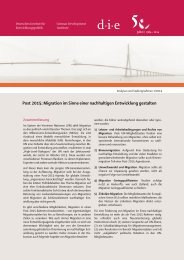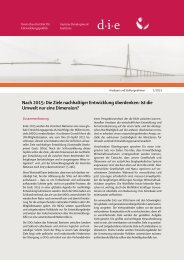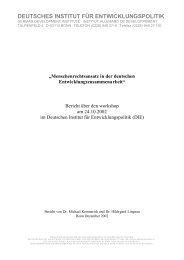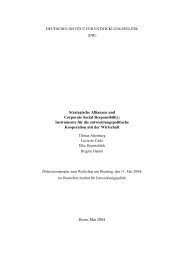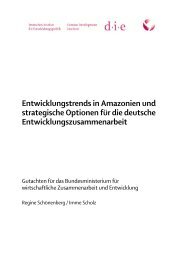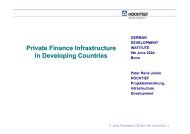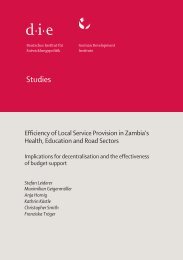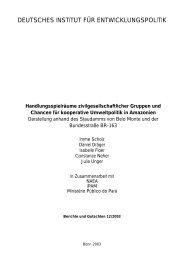Middle East / North Africa and the Millennium Development Goals ...
Middle East / North Africa and the Millennium Development Goals ...
Middle East / North Africa and the Millennium Development Goals ...
Create successful ePaper yourself
Turn your PDF publications into a flip-book with our unique Google optimized e-Paper software.
<strong>Middle</strong> <strong>East</strong> / <strong>North</strong> <strong>Africa</strong> <strong>and</strong> <strong>the</strong> <strong>Millennium</strong> <strong>Development</strong> <strong>Goals</strong><br />
3.1 Eradicating extreme poverty <strong>and</strong> hunger (MDG1)<br />
Most of <strong>the</strong> countries of <strong>the</strong> <strong>Middle</strong> <strong>East</strong> <strong>and</strong> <strong>North</strong> <strong>Africa</strong> will not reach<br />
MDG1 if <strong>the</strong>y do not undertake substantial additional efforts in <strong>the</strong> coming<br />
years. While it is true that <strong>the</strong> percentage of <strong>the</strong> population that is affected<br />
by hunger or lives on less than 1 US$ per day is lower here than in o<strong>the</strong>r<br />
regions of <strong>the</strong> world, since 1990 <strong>the</strong> relevant average regional figures have<br />
not declined, indeed <strong>the</strong>y have risen.<br />
Income poverty<br />
In 1990 only 2.1 % of all people in <strong>the</strong> MENA region had incomes lower<br />
than 1 US$ per day in purchasing power parities (PPP). This percentage<br />
was lower than in all o<strong>the</strong>r parts of <strong>the</strong> developing world, which led UNDP<br />
to conclude, in its 2003 HDR, that <strong>the</strong> MENA region had already reached<br />
Target 1 (to halve income poverty) of <strong>the</strong> MDGs (UNDP 2003a, 33).<br />
But implementation of <strong>the</strong> MDGs also depends on trends, <strong>and</strong> <strong>the</strong> trend for<br />
<strong>the</strong> percentage share of income poverty among <strong>the</strong> population of <strong>the</strong> <strong>Middle</strong><br />
<strong>East</strong> <strong>and</strong> <strong>North</strong> <strong>Africa</strong> has not declined. Instead, between 1990 <strong>and</strong><br />
2001 <strong>the</strong> figure even rose slightly to 2.2 %. The respective share of income-poor<br />
people in 2001 was 3 % in Egypt, 7 % in Lebanon, 2 % in Morocco,<br />
46 % in Mauritania, <strong>and</strong> 4 % in Jordan. There are no recent data<br />
available for <strong>the</strong> o<strong>the</strong>r countries of <strong>the</strong> region (see Table A2, Annex).<br />
Fur<strong>the</strong>rmore, <strong>the</strong> one-dollar indicator is appropriate only in a limited sense<br />
for <strong>the</strong> MENA region (ESCWA 2005). First, most countries in <strong>the</strong> region<br />
are middle-<strong>and</strong> low-income countries whose wage <strong>and</strong> price levels are so<br />
high that people <strong>the</strong>re cannot, even over <strong>the</strong> short term, live from 1 US$<br />
per day (Martens 2005). The practice of converting sums of money into<br />
PPPs does not do full justice to this state of affairs. Conversion is based on<br />
a market basket reflecting <strong>the</strong> composition of a country’s gross national<br />
product. A market basket of this kind may reflect <strong>the</strong> consumption patterns<br />
of <strong>the</strong> average citizen, but <strong>the</strong> corresponding basket of poorer households<br />
is made up quite differently. Poor households mainly consume staple foods<br />
<strong>and</strong> o<strong>the</strong>r essential goods (Bhalla 2004; Pogge / Reddy 2003a; Pogge /<br />
Reddy 2003b; Satterthwaite 2003; Zapado 2003). Second, several MENA<br />
countries have oil resources <strong>and</strong> are thus able to sell gasoline, heating oil,<br />
<strong>and</strong> o<strong>the</strong>r oil derivatives at low prices. These play a substantial role in calculating<br />
PPPs; <strong>and</strong> when 1 US$ is converted into a national currency, this<br />
German <strong>Development</strong> Institute 45



